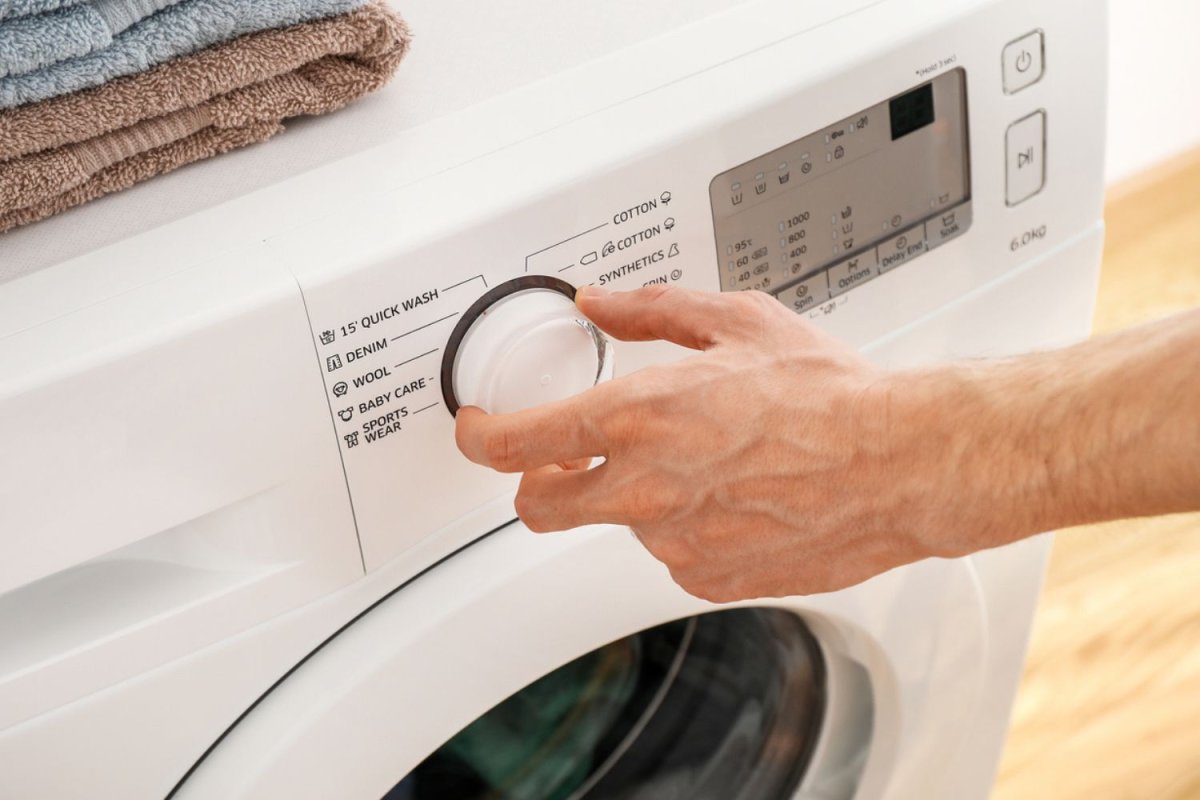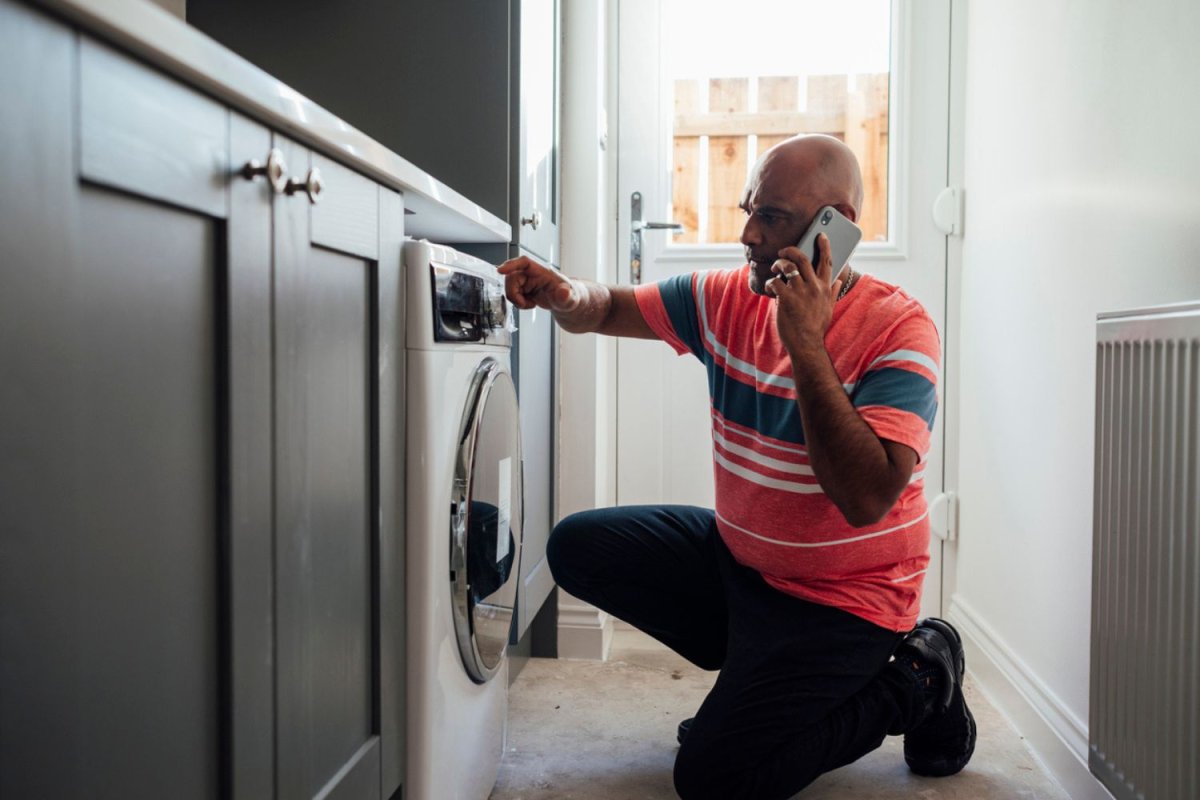We may earn revenue from the products available on this page and participate in affiliate programs. Learn More ›
What You Need to Know
- There are quite a few potential reasons for a washer not turning on, and some are more complex than others. It’s worth troubleshooting the problem before calling in a pro.
- Some of the most common reasons for a washer not turning on are a disconnected power supply, tripped breaker, worn-out control knobs, overheating, faulty lid or door switches, control board shorts, or motor issues.
- If the problem seems too complicated for a DIY fix or there are plumbing or electrical components involved, it’s a good idea to call a qualified technician for assistance.
- A home warranty can make the cost of frequent appliance repairs (including washer repairs) more manageable.
Q: I went to start a load of laundry, and the washing machine won’t turn on. Now it’s full of clothes and detergent, and I’m not sure what to do! Is this something I can fix myself? What good washing machine troubleshooting tips can I follow before calling a repair tech?
A: It’s frustrating when a washer won’t start, especially when you’re left with a tub full of clothes and detergent. The good news is that there are some simple ways to understand what the problem might be and whether it’s a DIY fix or a job for a professional. There are several common reasons a washer might refuse to cooperate, and many of them have straightforward solutions. Before shelling out money for repairs, it’s a good idea to check for simple fixes that can be easily remedied, such as a disconnected power cord or tripped breaker. Remember that even the best washers and dryers can have quirks, so it’s a good idea to consult the owner’s manual to troubleshoot the washing machine. But if the root cause of the washer not starting seems more complex, such as an issue with the control board or an electrical malfunction, it’s worth it to find out who to call to fix a washing machine in your area.
When a washer won’t turn on, it can be quite frustrating. Even if you don’t know how to fix a washing machine, there are seven common reasons the machine might be acting up.

1. The washer’s power cord may have become disconnected from the outlet.
Sometimes the power cord gets unplugged accidentally. Cords can vibrate loose over time, especially if the outlet is in an easily bumped location. Double-check that it’s securely connected to the electrical outlet. While checking the connection, it’s worth inspecting the entire length of the cord for any signs of damage. This could include fraying, cracks, or kinks in the outer casing. If you see any damage, don’t use the washing machine and consider calling a repair technician since a damaged cord can be a fire hazard.
2. The machine could also have lost power due to the circuit breaker tripping.
Typically, a circuit breaker trips because of an overloaded circuit, which is when more electrical current flows through the wires than they can handle. A tripped circuit breaker is another common culprit when a washer is not turning on.
Inside the panel of the circuit breaker, there will be labeled switches or levers. One of these will be designated for the washing machine. When there’s a tripped breaker, it will be in the middle position, or it might be slightly off to one side. If the washing machine breaker is tripped, carefully flip the switch firmly to the “on” position. If it trips again immediately, there might be a more serious electrical issue, and it’s best to call a qualified electrician.

3. Control knobs such as timers are some of the most common washer components to fail, resulting in the washer not turning on.
Control knobs, especially timer knobs, are a common reason a washer has stopped working. Over time, the plastic components inside the knob that allow it to turn and select cycles can wear out. The control knob itself might also have a faulty electrical connection due to corrosion or a loose wire, which could prevent the knob from turning on the washer as usual. In some cases, the entire timer mechanism behind the knob might be broken. To identify the issue, the first step is to look for any cracks or visible wear on the knob.
Some washing machines have a specific reset procedure for the control panel, which is a simple DIY washing machine fix. The user manual might recommend turning the knob a certain number of times in a specific direction. To reboot the washer, simply unplug it (or turn it off at the breaker box) for a few minutes (1 to 5 minutes will do) to clear any electrical hiccups. Plug it back in and power it on. This power cycle might be just the trick to get the washer working again, although it’s not a guaranteed fix. If the knob seems damaged or a reset doesn’t work, the knob may need to be replaced.
4. If the washer has been running continuously for several hours, the machine could be overheated.
If the washer has been running for an extended period and then you notice the washing machine not working, it may have shut down due to overheating. This is a safety feature built into many washers to prevent damage to the motor and other components. If this is the issue, it’s a good idea to turn off the washer and unplug it so it can cool down. It may take several hours to cool off completely. After the cooling period, plug the washer back in and try turning it on again. If overheating was the culprit, the washer will probably restart as usual.
If the washing machine is not turning on, or if the machine is overheating frequently, then it’s best to call a technician. There could be an underlying issue with the washer’s heating element or cooling system that needs professional attention.
5. If the washer is a top loader, there may be a problem with the lid switch. On a front loader, the door switch could be faulty.
The best washing machine brands have safety switches that prevent them from operating if the lid (top loader) or door (front loader) isn’t properly shut. However, in some cases damage or wear can cause the machine to sense that the door or lid is ajar when it is not. First, make sure nothing is preventing the lid or door from closing completely. An item of clothing caught in the seal could keep the switch from engaging. When the door or lid is shut on a working washer, there is a clicking sound as the switch makes contact. If there isn’t a click, the switch may be faulty.
It may be possible to see the part where the lid or door meets the washer frame. Look for any signs of physical damage to the switch itself. Replacing a lid or door switch on a broken washing machine usually requires disassembling part of the washer. This type of repair is usually best left to a technician who has experience fixing washing machines.
6. A short on the washer’s control board could also be to blame.
A short circuit on the washer’s control board can also be the reason the washer isn’t turning on. The control board is essentially the brain of the washing machine, regulating all the functions and cycles. A short circuit happens when electricity flows along an unintended path due to damaged wires or components on the board. Unfortunately, diagnosing and fixing a shorted control board is usually beyond the scope of a DIY repair.
Control boards have many tiny components, and pinpointing the exact location of the short circuit requires specialized knowledge and tools. If you’re not familiar with electronics repair, there’s a high chance of causing more damage to the control board while trying to fix it. If the control board has shorted, it’s best to call a qualified appliance repair technician, preferably someone who has experience repairing washing machines.
7. If the washer stopped mid-cycle, the machine’s motor may be broken.
A broken motor is a possibility, especially if the washer stopped abruptly mid-cycle and won’t turn on at all. The motor is the workhorse of the washing machine, powering the drum’s rotation during wash and spin cycles. A motor on its last legs might emit a burning odor. If there was a burning smell before the washer shut down, it may be a motor issue. Also, washing machine motors typically make a humming sound when they are working. If you try turning on the washer and hear no humming, it could indicate a problem with the motor.
Unfortunately, diagnosing a broken motor usually requires taking the washer apart to get a closer look. This is best left to a qualified appliance repair professional. They can assess the problem and determine whether the motor needs to be replaced. Replacing a washing machine motor can be expensive. Therefore, depending on the age of the washer, it might be more cost-effective to consider replacing the entire unit with one of the best washing machines on the market.
When to Call an Appliance Repair Technician
If the washer still isn’t turning on after a reasonable amount of troubleshooting, it’s time to call a qualified repair technician. Professionals can diagnose the problem quickly, saving clients time and frustration. One of the best appliance repair services will send a technician to figure out what’s wrong with the washer and recommend the best course of action. Repair techs have the knowledge and experience to pinpoint the exact problem, whether it’s a shorted control board, a faulty lid or door switch, or the washer won’t spin. They’ll also have access to the proper tools as well as replacement parts to get the washer working again.
Calling a repair tech might add to the cost of washer repairs. However, their expertise can be invaluable since they will be able to diagnose or fix the problem quickly and save you from causing further damage to the washer by attempting a DIY repair.
A Home Warranty Can Help With Appliance Repair Coverage
Since a washing machine lasts about 10 years on average, a home warranty with appliance coverage can be a lifesaver when it comes to the unexpected cost of washer repairs. While there are many potential problems a washing machine can develop, some of the most frequent issues are worn-out control knobs, a malfunctioning start switch, a washer not draining, a broken motor that can’t power the drum, and electrical problems like a short circuit in the main control board. One of the most expensive parts to replace on a washing machine is the drum, which can cost anywhere from $350 to $550. Many home warranty plans cover repairs for major appliances like washing machines. In some cases, if the washer can’t be repaired, the warranty may even cover replacement costs. Having a safety net in place for appliance breakdowns can provide valuable peace of mind, especially for expensive repairs.
If you’re considering a home warranty, do your research and compare plans from different providers to find the best home warranty companies (such as American Home Shield or AFC Home Club) that suit your needs and budget.


